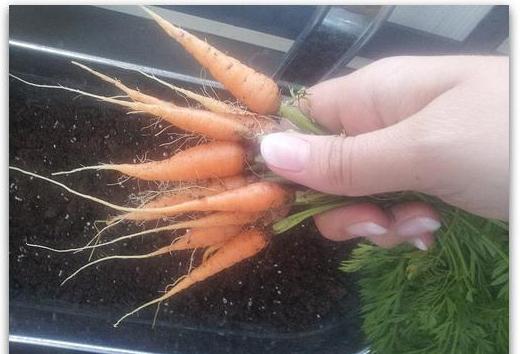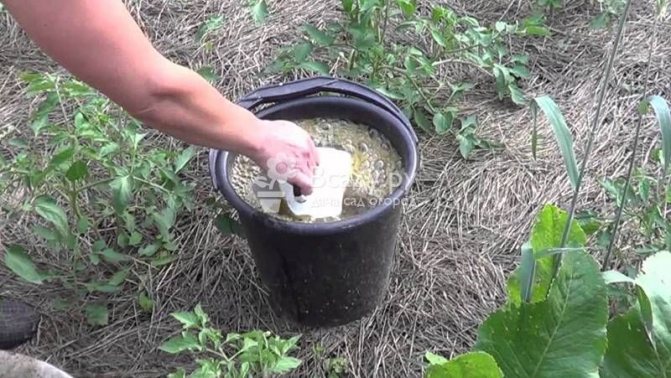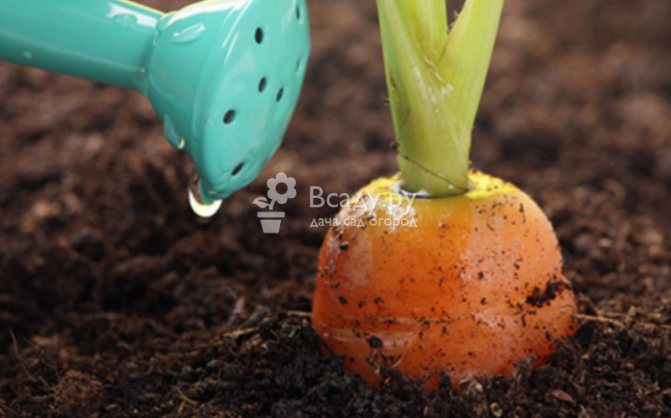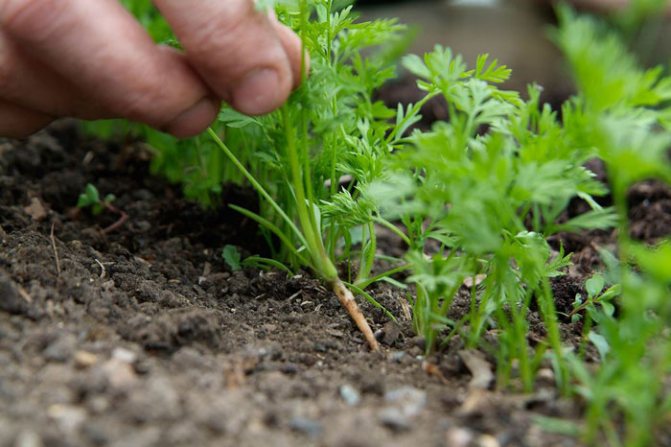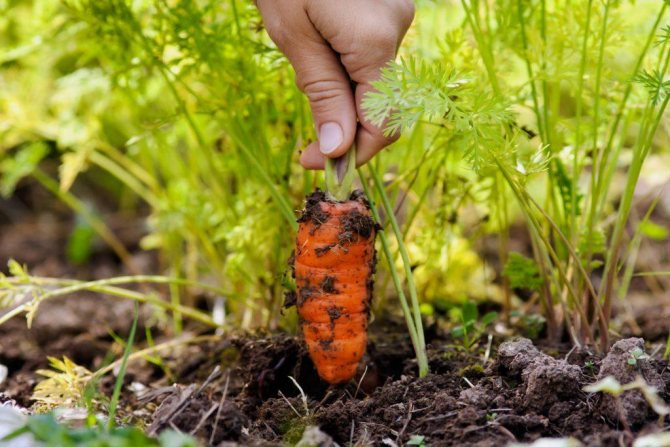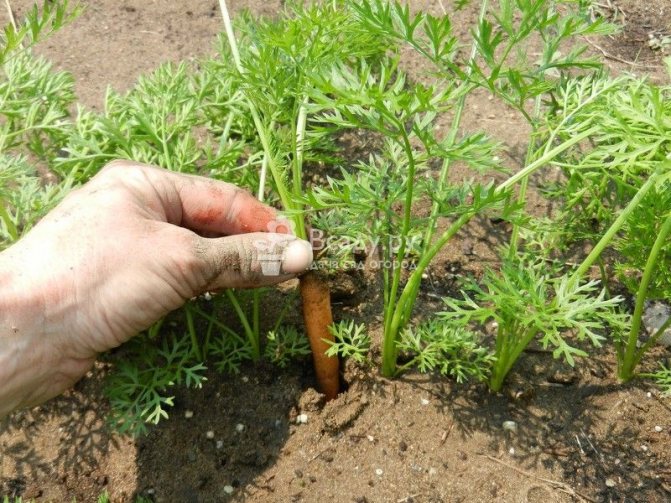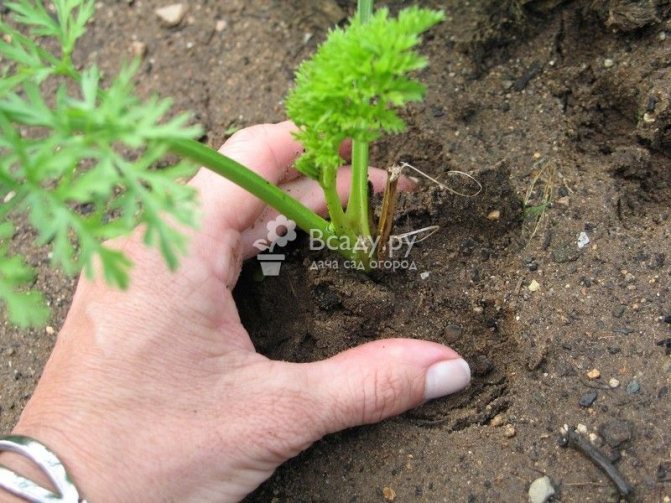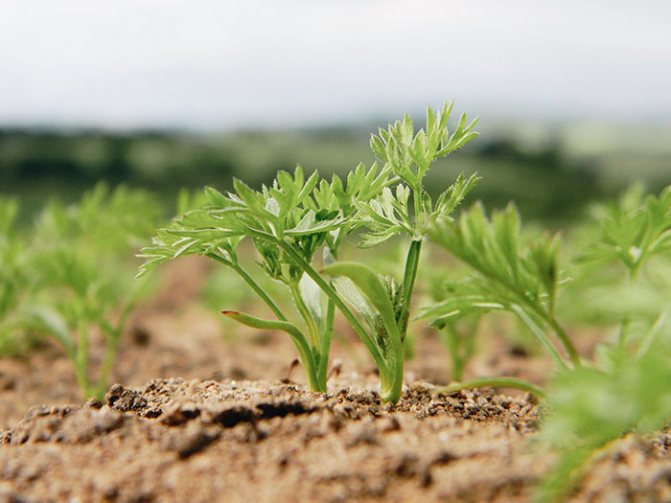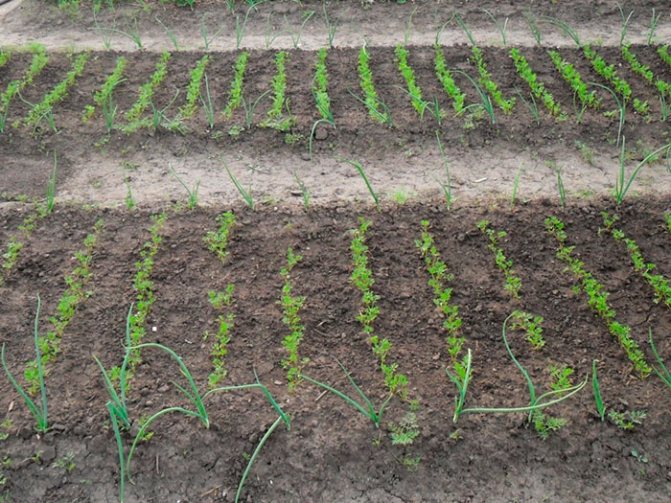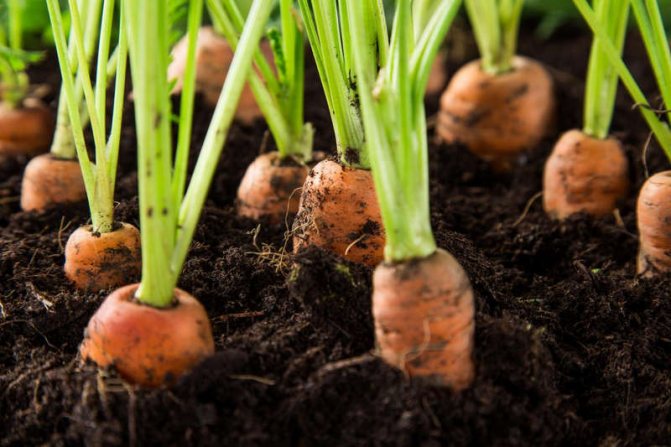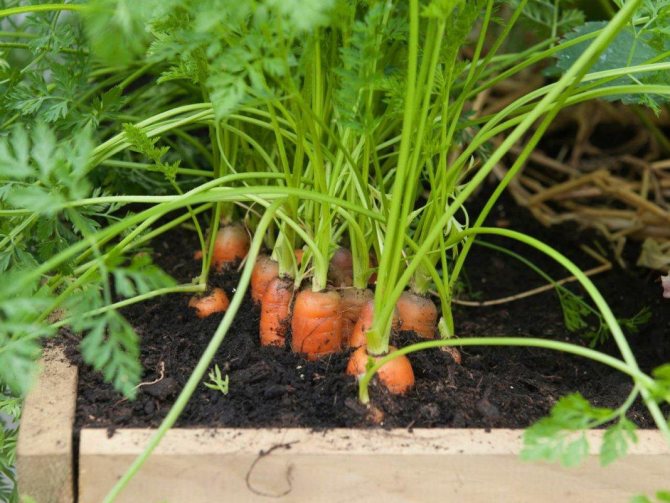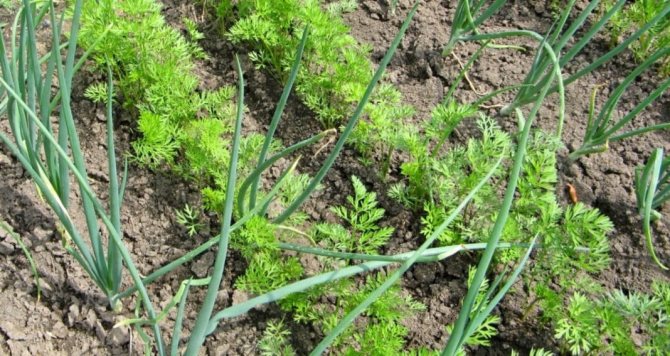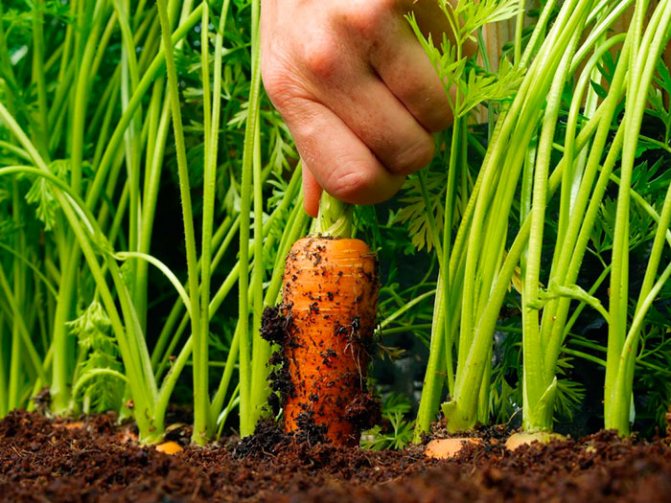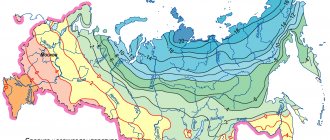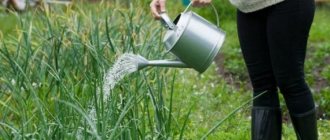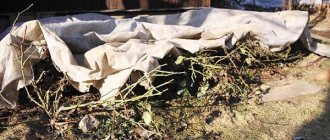Author rating
The author of the article
Yakov Pavlovich
Professor, Head of the Department of Vegetable Growing
Articles written
153
To get a good harvest, you need to carefully look after the planted vegetables. Carrots are an unpretentious plant, however, they also require serious care. It often happens that the seeds were planted too densely and as a result, the gardener received uneven shoots with a solid carpet. If this happens, it is important to know how to properly thin out the carrots so that the roots are healthy and large.
Why thin out carrots?
Thinning carrots is the periodic removal of excess shoots. Pulling the beds is necessary if the carrots have risen too thickly. The thinning procedure creates the necessary conditions for proper growth of carrots and helps to get rid of weak sprouts. With a thickened planting, vegetables interfere with each other's development, their root system is intertwined, as a result, root crops are obtained of an irregular shape. In addition, plants lack nutrients. Thinning of seedlings gives a good result: uniform growth of fruits, high yield and large root crops.
The benefits of thinning
If the vegetable is grown by free-form seed-furrowing, the seeds have poor germination and the seedlings grow erratically.
Seeds are planted with a dense carpet. When shoots appear, thinning of carrot plantings is carried out.
It is worth thinning carrots periodically to evenly distribute the sprouts in the garden and increase the size of root crops. Dense shoots of carrots interfere with the development of neighboring bushes. Timely weeding allows plants to receive the necessary nutrients required for the development of vegetable crops. If you do not thin them out in a timely manner, the fruits will grow deformed, with growths.
Weeding tip
When the seeds are sown, the beds are covered with moistened newspapers in 8-10 layers, a film is placed on top of them. You should get a greenhouse that perfectly retains moisture, the elevated temperature does not allow weeds to grow. After 2 weeks, the greenhouse is removed, shoots should appear soon. Weeds grow in parallel with the seedlings. After 10 days, the weed plants are ready for weeding, the carrots will be more convenient to thin out. Rinse the vegetable when 2 leaves appear.
Dates of the
As a rule, they begin to deal with the removal of unnecessary shoots after three real leaves are formed on the garden bed. During this period, you can already see where the maximum compaction is located. In some cases, this event is carried out in 2 stages: immediately after the appearance of two leaves and then three weeks later, when the tops reach ten cm. You should first water the carrot beds - it is easier to remove the sprouts without damaging the neighboring ones. After thinning, the sprouts are piled up and covered with earth with sawdust - so they will not be able to attract pests with their smell.
When and at what time is it necessary to thin out carrot seedlings
For the entire period of growth and development of carrots, it is thinned out no more than two times, so as not to unnecessarily disturb the root system of other seedlings.For the first time, the procedure is performed after the emergence of two real leaves on the seedlings, when it is already clearly visible where the planting density is normal, and where it is too thickened.
Find out which crops to plant carrots in the open field after.
Usually this time falls on 5-6 weeks after sowing the seeds in the ground, and the main task in this case is to leave a free space of 2-3 cm between neighboring plants. The second time the seedlings are thinned out 3-4 weeks after the previous procedure, as soon as 4–6 full-fledged leaves will appear on the plants (usually this time falls on June or July).
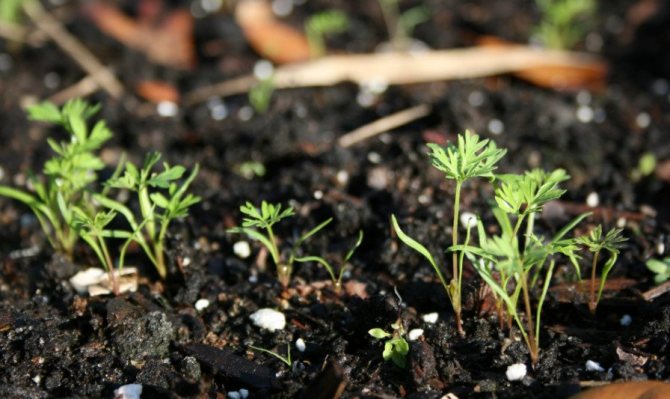
How to carry out the procedure correctly?
As a rule, the thinning procedure in open ground is carried out without special tools or devices - it is performed mechanically (manually). Additionally, it is worth equipping yourself with gloves so as not to get dirty. When weeding for the first time, the sprouts are simply removed from the ground. However, during the second procedure, the root system grows more strongly into the ground and it is more difficult to cope with this task. You can pull on extra shoots in several ways:
- Manually - removal is done as carefully as possible, capturing two leaves. It is preliminarily recommended to moisten the soil so that the plant can easily come out with the root. When pulling, you need to try to pull the sprout up so as not to damage the neighboring plants.
- Tweezers - Large tweezers help to cope with thinning in the first stage, when the sprouts are very small. The tool needs to grab the stem very close to the ground and pull it out with a sharp movement.
- Using scissors is a fairly quick way to remove interfering processes. Only sharpened tools are suitable for this method. With scissors as close to the surface of the soil and the base as possible, cut off the aerial part of the plant. Do not worry about the remaining roots - over time, they will dry out on their own and do not have to be removed.
- Using a knife to remove sprouts is a rather dangerous method of thinning, since during the procedure there is a high risk of damage to adjacent roots. At a depth of 2-3 cm, several shoots are pryed at once with a knife and taken out from the roots.
See also Why and what to do if the carrots do not sprout
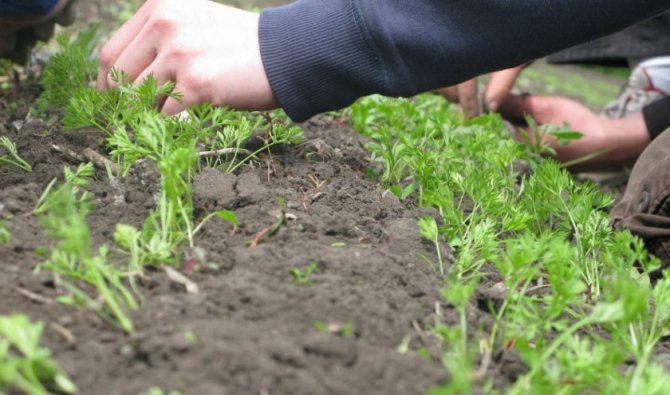

As a result of thinning, there should be a distance of at least 20 cm between the rows with carrots, and at least 3 cm between the shoots in the garden.After the second thinning, the gap between the shoots should be 6 cm.However, these indicators directly depend on the size of a certain variety. The plants should be pretreated with special compounds that will scare off the carrot fly. In parallel, you can eliminate weeds that clog the beds with root crops.
Immediately after removing the underdeveloped shoots, it is necessary to water the plant, as well as to huddle the soil around them. The top of the carrots should be 5 cm underground to avoid sunburn. It is recommended to add mineral compositions, combining with regular irrigation with settled water. As soon as the root crop grows green mass, they begin to feed it with superphosphate. It is worth noting that the soil loosened after the procedure needs to be compacted - so the pests will not be able to lay eggs. All tools the gardener works with must be disinfected.
Diseases and pests of carrots
Closer to the ripening period of carrots, the fruits can infect diseases and parasites, attracted by the sweet smell and taste.
One of the diseases of carrots is rot. It can be white, gray, felt and dry.
White Rot caused by the fungus Sclerotinia sclerotiorum. It spreads easily and can cause great harm to the crop during the storage stage.
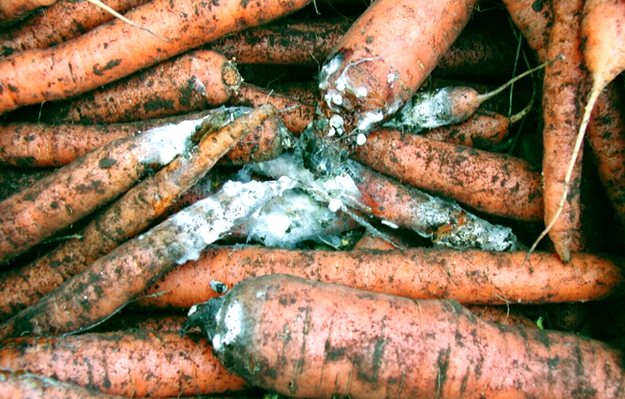

White rot
Signs: Carrot fruits are covered with a white bloom, with black dots on top and mucus on the bottom.
Recommendations for treatment and prevention:
- using proven, healthy seeds;
- fertilization of carrots with potash and phosphorus fertilizers to increase their immunity;
- harvesting in dry weather;
- weed out injured fruits (they are most susceptible to infection), as well as fruits with signs of damage;
- disinfection of the storage of carrots before storage with a sulfur checker;
- storage of carrots at 1-2 degrees.
Dry rot or Fomoz Is the fungus Phoma rostrupii Sacc. It affects already almost healthy fruits and, upon subsequent storage, spreads to the entire crop.


Dry rot (phomosis)
Signs: elongated, dark spots appear on the leaves, and dark, depressed spots on the top with black dots on the fruits are fungal spores.
Recommendations for treatment and prevention:
- destroy fruits with signs of disease before storage;
- disinfection of the storage of carrots before storage with a sulfur checker;
- storage of carrots at 1-2 degrees.
- to collect and destroy the tops before storage;
- fertilization of carrots with potash and phosphorus fertilizers to increase their immunity;
- compliance with crop rotation.


Brown spot
Another disease of carrots is brown spot, also caused by a fungus.
Signs: It is expressed in dark brown constrictions on the lower parts of the stem, near the soil. Young plants die quickly. On already adult plants, the disease manifests itself during the formation of the fetus. The leaves are covered with brown spots, curl, light brown spots appear on the fruits.
Recommendations for treatment and prevention:
- fertilization of carrots with potash and phosphorus fertilizers to increase their immunity;
- planting resistant crops;
- spray the stems of the plant with celandine broth.
Alternaria or black rot, is not caused by a fungus - it is an infectious disease of the plant.


Alternaria or black rot
Signs: it manifests itself in the blackening of the stem. On young leaves, this manifests itself immediately, the leaves curl and acquire a dark color. A spot of coal-black color appears on root crops.
Recommendations for treatment and prevention:
- remove all remnants of vegetation from the beds;
- compliance with crop rotation;
- planting resistant crops;
- fertilization of carrots with potash and phosphorus fertilizers to increase their immunity;
- strengthening the plant's immunity with a solution of "Baikal-M" and "Immunocytophyte";
- remove damaged fruits from the site.
Another disease of carrots - powdery mildewcaused by a fungus.


Powdery mildew
Signs: it is expressed by a white bloom on any part of the plant, then, with increasing distribution, the leaves begin to turn brown and wither. The roots become hard and stop growing.
Recommendations for treatment and prevention:
- thinning the beds;
- watering with warm water;
- fungicide treatment during the growing season;
- strengthening the plant's immunity with a solution of "Baikal-M" and "Immunocytophyte";
- destruction of plant residues from the beds.
Consequences of mistakes
Quite often it happens that an inexperienced gardener thinns carrots incorrectly, violating the technology and procedure for removing unnecessary and weak shoots. If the thinning procedure is carried out too late, you can damage nearby roots, and this in turn will lead to deformation of the plant. A damaged root system causes the growth of the root crop to stop, and instead, lateral shoots begin to develop. In addition, when growing root crops are damaged, they begin to rot quickly. And also if you do not observe the correct distance between the shoots, you can get a "gnarled" crop, since the fruits will be deprived of the necessary nutrition.


The check word for the word "defuse"
In Russian, the word "defuse" has several meanings.
I give a doll, a bride, children for the carnival, that is, dress very beautifully,
then the spelling of the letter "I" will be checked by related words:
If a hunter shoots a gun or, in a figurative sense, should
to defuse the political situation, the tense situation in the team, between people, states,
then the spelling of the letter "I" in the root of the verb in question will be confirmed by related words:
Test words for the word "defuse":
Examples of
It's time to break up the carrot crops.
Do you want to discharge your baby for the New Year?
Is it possible to plant carrots after thinning
In most cases, transplanting thinned carrots does not give positive results. As a rule, as a result of such actions, branched and hairy carrots of very small sizes grow in the garden. It is for this reason that carrots and other root crops are not planted with seedlings, since they do not take root well. However, some gardeners still resort to such actions and get a harvest of carrots.
To plant a thinned one, it is necessary to use the removed shoots after the first stage of thinning, while they are very small in size. Transplanting root crops at the second stage is completely pointless - the plant will constantly get sick and the harvest will be poor. At the chosen place, you should mark the holes with a pencil and plant the remote sprouts on them. Further, the soil around the plantings must be compacted and watered abundantly. With careful care, thinned carrots can give a good boost to the vegetable yield.
See also Fertilizers for feeding carrots in the open field
Transplanting weeded carrots
Many inexperienced summer residents doubt and wonder whether it is possible to plant carrots after thinning. The answer is - if no other application can be found, then why not.
Not all seedlings will take root, you need to be aware of this. But some part will grow and give a harvest. In this case, the likelihood of getting deformed specimens increases significantly. Yes, and large root crops should not be expected.
Advice! We use the greens of weeded carrots for cooking, put them in a compost pit, and feed them to livestock and poultry.
Choosing a place for the garden
- Carrots should be placed in well-lit areas... Growing in the shade will lead to a significant decrease in yield and a deterioration in taste. Therefore, it is worth allocating an area for carrots that is in direct sunlight throughout the day.
- In addition, it is necessary to take into account crop rotation - the order of growing crops in a specific area.
You can not plant carrots annually on the same bed or after such plants:
- parsley;
- dill;
- parsnip;
- celery.
Ideal "predecessors" for this root crop will be:
- tomatoes;
- cucumbers;
- onion;
- garlic;
- potatoes;
- cabbage.
Seed preparation and sowing
Presowing preparation allows you to immediately identify "defective" seeds and accelerates germination. Therefore, you should not neglect this stage. Moreover, the procedure requires almost no effort.
- First, the seeds must be poured with warm water. After 10 hours, the entire "illiquid" will emerge.
- To speed up germination by a week or even more, you need to carry out one more simple manipulation. The seeds are placed on a damp piece of cloth or cotton and kept there for several days. The air temperature should vary within +20. + 24 ° C. In such conditions, after three days the seeds will hatch - fragile roots will appear.
- Before sowing, it is necessary to dig out the grooves and moisten them well. They should not be too shallow, so that strong gusts of wind do not spread the seeds throughout the area. Do not make grooves too deep. Otherwise, the seeds will not germinate at all. The optimum planting depth ranges from 2 to 3 cm.The distance between adjacent grooves is at least 15 cm, between seeds - at least 2 cm.
The best varieties of carrots
The choice of carrots on the shelves of modern stores can confuse a novice gardener. In order not to panic and collect a dozen bright bags at random, you need to understand why you are growing carrots. Different varieties are suitable for different purposes.
For sale in bundles and fresh consumption in summer: Bureau, Vesta F1, Victoria F1, Concerto F1, Laguna F1, Lydia F1, Mars, Napoli F1, Nelly F1, Orange Muscat, Buchkovaya, Royal Chanson, Royal Chantenay, Yaroslavna.
For salads: Bolero F1, Napoli F1, Red Core, Chantenay 5.
For processing: Boltex F1, Veronica F1, Vita Longa, Dolyanka, Cardinal, Chinese beauty, Autumn Queen, Crown F1, Kuroda F1, Malika, Nantes improved, Natalia F1, Princess F1, Romance F1, Samson, Forto, Holiday F1.
For winter storage: Anastasia F1, Gribovchanin F1, Canada F1, Cascade F1, Queen of Autumn, Moscow Winter, Nantes, Romance F1, Typhoon, Flacque, Flaccoro, Chantenay 2461, Elegance F1.
Universal varieties: Angara, Major F1, Red Giant.
Where to plant carrots
Ridges for spring sowing of carrots should be prepared in the fall. This root crop does not have many requirements, but it is worth observing all of them, since the wrong place will lead to a decrease in the yield and taste of carrots.
Choosing a place for carrots
Carrots are one of those vegetables that should be in direct sunlight all day long. Therefore, under the ridges it is worth assigning the most illuminated place on the site. In addition, it prefers loose neutral soils, and on heavy or acidic soils, it becomes covered with a "beard" and deforms.
Carrots cannot be planted in one place for 2 years in a row. In addition, it is not recommended to grow it after parsley, dill, celery and parsnips. But cucumbers, tomatoes, potatoes, onions, garlic or cabbage will be excellent precursors for this crop.
Preparing the bed for carrots
After you have decided on the planting site, you need to take care of the quality of the land for carrots. This is done in September and consists of several stages:
- removal of weeds and plant debris from previous plantings;
- digging the ridge;
- introduction of organic baking powder (peat, sand, humus);
- deoxidation of the soil, if necessary, using dolomite flour, hydrated lime (fluff) or ash.
Carrots do not tolerate fresh manure, they become bitter from it, with a thick skin and build up mainly tops, and not root crops.
How to leave carrots in the garden for the winter?
The need to store a vegetable in the garden in most cases arises when there is a large harvest. The advantage is keeping the roots fresh (in the cellar, there are often situations when carrots wither and become unusable). To store a vegetable in the garden, you need to stop watering a month before cutting the tops.
After a month, the weeds are harvested, and the tops are cut off at the root. Then the garden bed and the surrounding area (1 m) are covered with sand (the layer height should not exceed 5 cm) and covered with a polyethylene film. To create the next - insulating - layer, sawdust, leaves or peat are used. The insulating layer is covered with plastic wrap or roofing felt, the fixing of which is carried out using improvised materials.
Second weeding
After about another week, when the second real leaf appears, weeding should be repeated. Since you are already quite able to thin out the carrots in the garden, you need to draw the latter, leaving at least 2-2.5 cm between the plants.Some do it by eye, others pull the line between the pegs and strictly leave only those plants that fall in the given order. Between weeding and thinning, the bed should be watered abundantly. By pulling carrots out of dry soil, you can cut off their tails, and this will lead to the appearance of a large number of peduncles.
